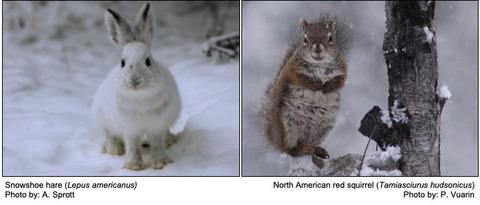当前位置:
X-MOL 学术
›
Funct. Ecol.
›
论文详情
Our official English website, www.x-mol.net, welcomes your
feedback! (Note: you will need to create a separate account there.)
Body temperature, heart rate, and activity patterns of two boreal homeotherms in winter: Homeostasis, allostasis, and ecological coexistence
Functional Ecology ( IF 4.6 ) Pub Date : 2020-07-23 , DOI: 10.1111/1365-2435.13640 Allyson K. Menzies 1 , Emily K. Studd 1, 2 , Yasmine N. Majchrzak 2 , Michael J. L. Peers 2 , Stan Boutin 2 , Ben Dantzer 3, 4 , Jeffrey E. Lane 5 , Andrew G. McAdam 6 , Murray M. Humphries 1
中文翻译:

冬季两种北温的体温,心率和活动模式:稳态,同构平衡和生态共存
更新日期:2020-07-23
Functional Ecology ( IF 4.6 ) Pub Date : 2020-07-23 , DOI: 10.1111/1365-2435.13640 Allyson K. Menzies 1 , Emily K. Studd 1, 2 , Yasmine N. Majchrzak 2 , Michael J. L. Peers 2 , Stan Boutin 2 , Ben Dantzer 3, 4 , Jeffrey E. Lane 5 , Andrew G. McAdam 6 , Murray M. Humphries 1
Affiliation

|
- Organisms survive environmental variation by combining homeostatic regulation of critical states with allostatic variation of other traits, and species differences in these responses can contribute to coexistence in temporally variable environments.
- In this paper, we simultaneously record variation in three functional traits—body temperature (Tb), heart rate and activity—in relation to three forms of environmental variation—air temperature (Ta), photoperiod and experimentally manipulated resource levels—in free‐ranging snowshoe hares and North American red squirrels to characterize distinctions in homeotherm responses to the extreme conditions of northern boreal winters.
- Hares and squirrels differed in the level and precision of Tb regulation, but also in the allostatic pathways necessary to maintain thermal homeostasis. Hares demonstrated a stronger metabolic pathway (through heart rate variation reflective of the thermogenesis), while squirrels demonstrated a stronger behavioural pathway (through activity variation that minimizes cold exposure).
- As intermediate‐sized, winter‐active homeotherms, hares and squirrels share many functional attributes, yet, through the integrated monitoring of multiple functional traits in response to shared environmental variation, our study reveals many pairwise species differences in homeostatic and allostatic traits, that both define and are defined by the natural history, functional niches and coexistence of sympatric species.
中文翻译:

冬季两种北温的体温,心率和活动模式:稳态,同构平衡和生态共存
- 有机体通过将关键状态的稳态调节与其他性状的静态调节相结合,从而在环境变化中生存下来,这些响应中的物种差异可促进时变环境中的共存。
- 在本文中,我们同时免费记录了三种功能性状的变化:体温(T b),心率和活动-与三种形式的环境变化有关-气温(T a),光周期和实验控制的资源水平-范围广泛的雪鞋野兔和北美红松鼠,表现出对北方北方冬季极端条件的同温反应的差异。
- 野兔和松鼠在调节T b的水平和精度上不同,但在维持热稳态所需的同化途径上也有所不同。野兔表现出更强的代谢途径(通过反映生热的心率变化),而松鼠表现出更强的行为途径(通过使冷暴露最小化的活动变化)。
- 由于中等规模的冬季活跃的等温线,野兔和松鼠具有许多功能属性,但是,通过对共享的环境变化做出响应的多种功能性状的综合监测,我们的研究揭示了稳态和同态性状的成对物种差异,定义并由同伴物种的自然历史,功能生态位和共存来定义。









































 京公网安备 11010802027423号
京公网安备 11010802027423号